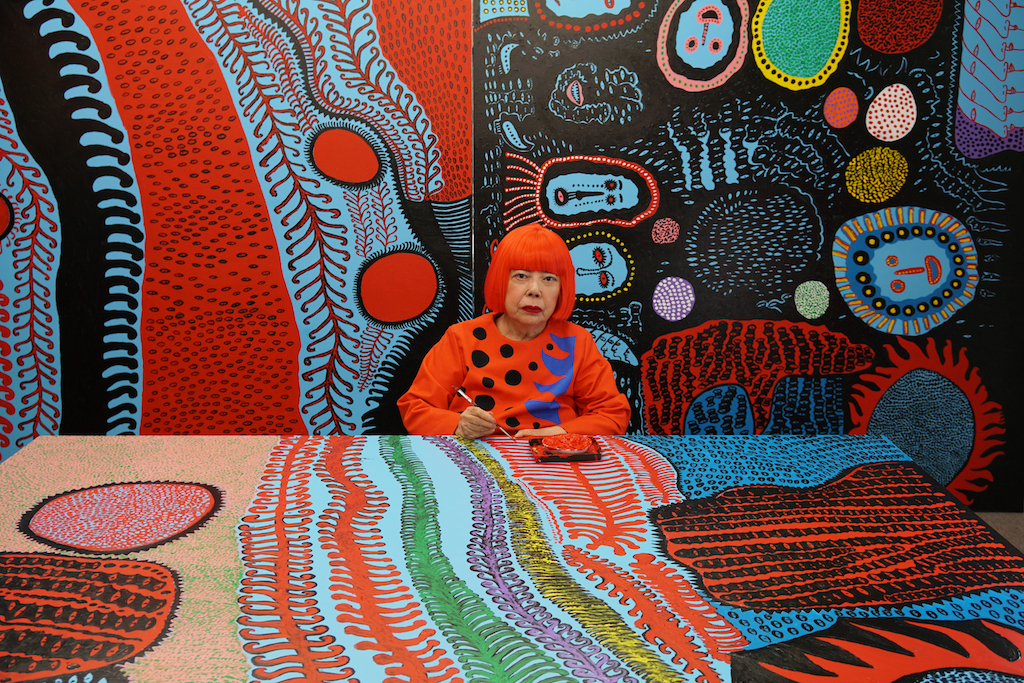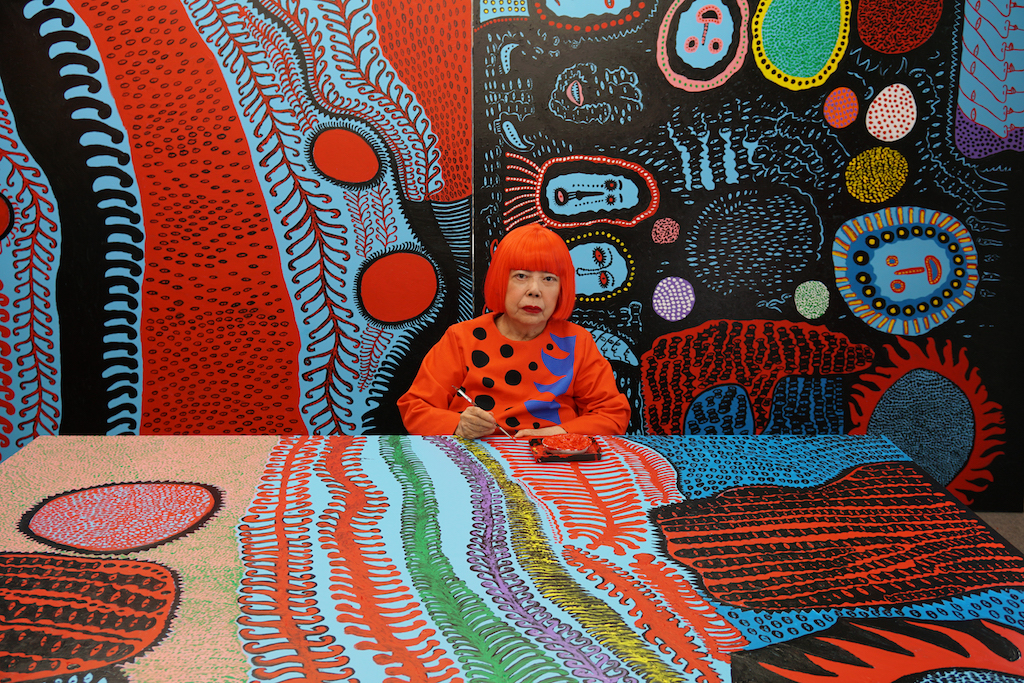[ad_1]

Portrait of Yayoi Kusama in her studio.
IMAGE ©YAYOI KUSAMA/COURTESY DAVID ZWIRNER, NEW YORK; OTA FINE ARTS, TOKYO/SINGAPORE/SHANGHAI; VICTORIA MIRO, LONDON; YAYOI KUSAMA INC.
In the opening moments of Heather Lenz’s new documentary, Kusama: Infinity, the artist Yayoi Kusama, donning a bright red dress and wig to match, describes “the sense of being obliterated by flowers” as a child in a field near her home in Matsumoto, in Japan’s Nagano prefecture. Presented in the film as a “traumatic” event, this early experience was a formative one, even though it’s a bit unclear what, exactly, she means. Her words are effective, however—they invoke an ongoing sense of panic that continues to haunt the artist.
Although her work is some of the most talked-about art on the planet right now, generating long lines and hundreds of thousands of Instagram posts, Kusama has been vocal about the fact that her success hasn’t necessarily led to happiness. Lenz’s documentary, which opens in select theaters in New York and Los Angeles next Friday, relays some of Kusama’s personal struggles—her dysfunctional family, her attempts to penetrate and conquer the New York art world of the 1960s, and her experiences with mental-health issues are all focal points in the film. Featuring interviews with Kusama, as well as fellow artists, curators, and friends, the film is a revealing document for fans of the artist and more casual viewers alike.
At various points in the film, Kusama is shown frantically creating artwork, decorating surfaces with her signature dot motifs. “My canvas cannot keep up with me,” she says, and it’s true—we soon find out that her feverish process and visually stunning work may reveal more about her personal life than is initially obvious. The beginning of Kusama: Infinity focuses on the artist’s upbringing. We learn that, despite her mother’s discouragement, Kusama began making paintings and drawings at age 10. On one occasion, her mother abruptly snatched a work from Kusama’s hands, an incident that may have informed the frenetic pace at which she works.
But Kusama’s tense childhood was not the only influence on her early work, much of which made use of repetitive abstract patterns constructed from consumer objects—there were art-historical inspirations, too. During her mid-20s, before moving to the United States, Kusama and Georgia O’Keeffe began sending each other letters. O’Keeffe promised to look into exhibition opportunities for the young artist, who, before leaving Japan, burned about 2,000 of her paintings. Apparently influenced by a heady sense of ambition, Kusama vowed to create better work when she arrived in the States. She soon moved to Seattle in 1957, ultimately settling in New York one year later.

Artist Yayoi Kusama next to her Dot Car (1965) in Kusama: Infinity.
©HARRIE VERSTAPPEN/COURTESY MAGNOLIA PICUTRES
The richest part of the documentary chronicles the many challenges Kusama faced as a Japanese woman hoping to “create a new history of art in the U.S.A.,” as she recounts to Lenz. Artist Carolee Schneemann reflects in the film that Kusama was “blatant, aggressive, and overt” when it came to getting her work into galleries and making a name for herself in the art world.
Writing in ARTnews in 1959, the sculptor Donald Judd called Kusama an “original painter.” He was hardly her only admirer, however, as the film makes clear. In one interview in the documentary, Frank Stella says that he paid $75 for a painting she showed at the exhibition Judd reviewed, a solo outing at New York’s Brata Gallery in 1959—he appreciated its “tactile quality.”
Kusama: Infinity also delves into Kusama’s romantic relationship with artist Joseph Cornell, who was 26 years her elder. They met in the mid-1960s, and Cornell, overcome with infatuation, once sent her 14 letters in a single day. It seems that assertive mothers were a theme in Kusama’s life—on one occasion, Cornell’s mother dumped cold water on the couple while they were kissing, an intervention that ruined Kusama’s embroidered dress.
As the 1960s went on, Kusama became more widely known, and exhibitions of her work became increasingly frequent. Receiving such recognition was unusual for a female artist of her era, but it did not safeguard her against being copied. The film alleges that male artists like Andy Warhol, Lucas Samaras, and Claes Oldenburg were imitators of some of her ideas and forms. Kusama apparently herself felt similarly. Depressed at one point, not long after learning of their riffs on her work, she flung herself from a window; a bicycle broke her fall.
“Why can’t I sell my art like ice cream or hot dogs?” Kusama says at one point, speaking to the camera as she recalls her early years. The film suggests that the reasons may have something to do with her 1960s work’s experimental nature. At the 1966 Venice Biennale, Kusama, working without the permission of local authorities, staged her installation Narcissus Garden—a sea of silver globes arranged on the ground—outside the Italian Pavilion. (A version of it is currently on view at New York’s Rockaway Beach, courtesy of MoMA PS1.) A Vietnam War protest at which Kusama appeared nude followed shortly thereafter, and it shook the New York art world. Amid these scandals, she returned to Japan in the early 1970s. Kusama’s arrival there was so controversial, her high school even removed her name from its alumni list.
The remainder of the documentary tells of Kusama’s redemptive return to form in the New York art world, which she achieved by way of a 1989 retrospective of her work at the now-defunct Center for International Contemporary Arts. Then came another auspicious development: the 1993 Venice Biennale, where Kusama became the first woman to represent Japan at the storied exhibition. But anyone who knows even a little about Kusama will recognize that the film skips over quite a bit in the artist’s narrative. In 1977, after experiencing paranoia and hallucinations, Kusama committed herself to a mental hospital in Tokyo, where she has remained ever since. Though this is mentioned in Kusama: Infinity, it is relegated to the background of the artist’s story by the film’s generally uplifting conclusion. Also briefly mentioned is the sudden market-driven interest in her work, spurred on both by her representation by David Zwirner, one of the world’s most influential galleries, and by a traveling retrospective that drew massive crowds at the Whitney Museum, the Reina Sofia in Madrid, and elsewhere.
Then there’s the issue of Kusama’s widespread appeal. Kusama’s “Infinity Room” installations—usually cuboidal spaces that are adorned with mirrors and glowing lights—have become social-media fodder; people line up outside galleries and museums for hours just to see them, in some cases even camping out overnight. Few other artists can lay claim to such a loyal mainstream following these days. What of the fact that Kusama’s work is some of the most visible art in the world right now?
With no mention of her luxury-brand collaborations and only a perfunctory nod to her blockbuster exhibitions and the general mania surrounding her oeuvre, what’s missing from Kusama: Infinity is a proper look at the artist’s popularity. The documentary ends with a line from a poem written by the artist: “I want to live forever.” It’s clear that she will, in the form of monographs, essays, and films, but also in the form of $500 Louis Vuitton clutch purses and crowd-inducing gallery shows. More than anything else, the film suggests that the artist’s career and persona continue to elude any easy understanding, and that we’ll likely spend an infinite amount of time trying to figure her out.
[ad_2]
Source link

